北师大版(2019)选择性必修 第一册Unit 3 ConservationUnit 3 Lesson 1 The Sixth Extinction课件 (共15张PPT)
文档属性
| 名称 | 北师大版(2019)选择性必修 第一册Unit 3 ConservationUnit 3 Lesson 1 The Sixth Extinction课件 (共15张PPT) | 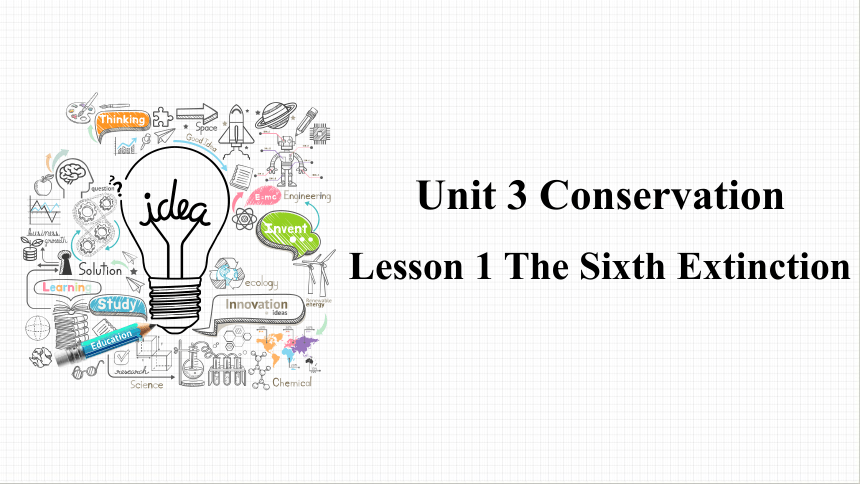 | |
| 格式 | pptx | ||
| 文件大小 | 3.9MB | ||
| 资源类型 | 教案 | ||
| 版本资源 | 北师大版(2019) | ||
| 科目 | 英语 | ||
| 更新时间 | 2024-10-12 22:45:28 | ||
图片预览

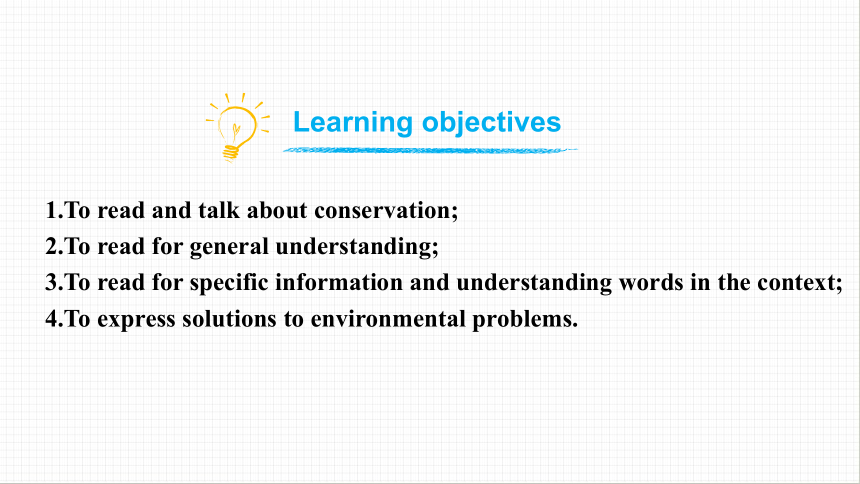
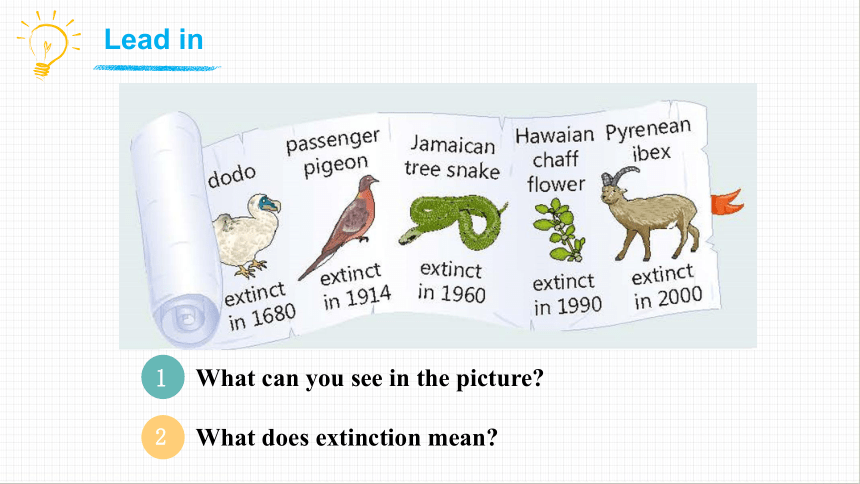
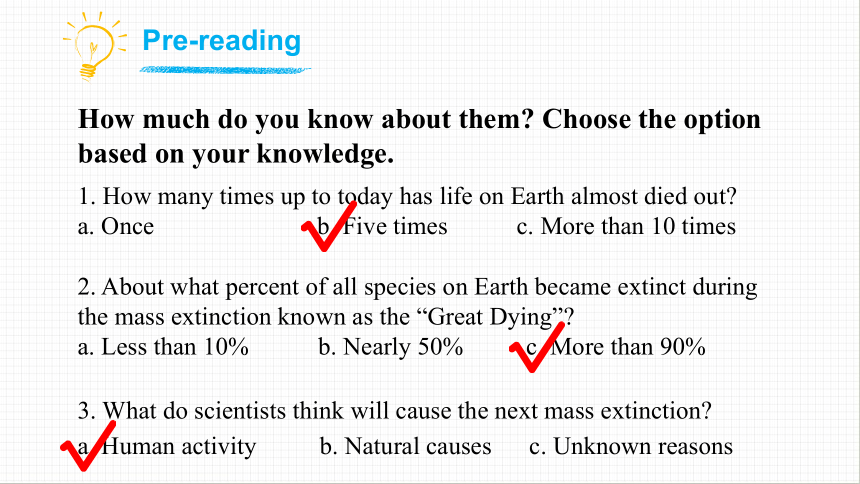
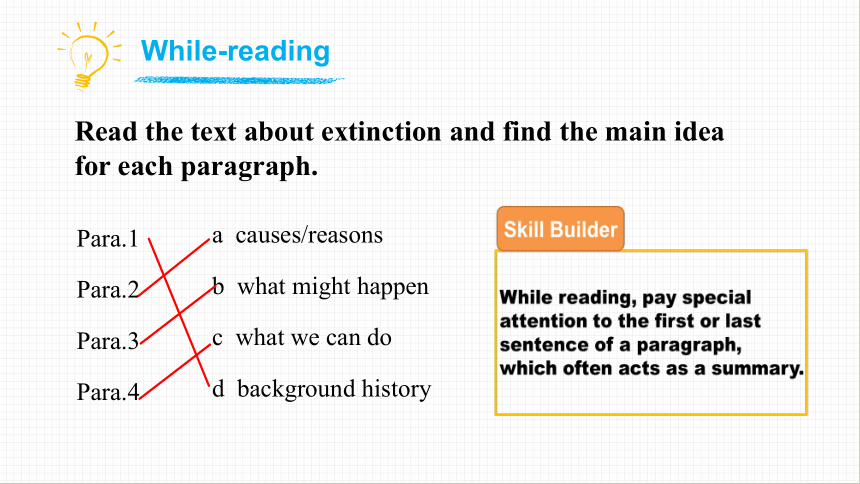
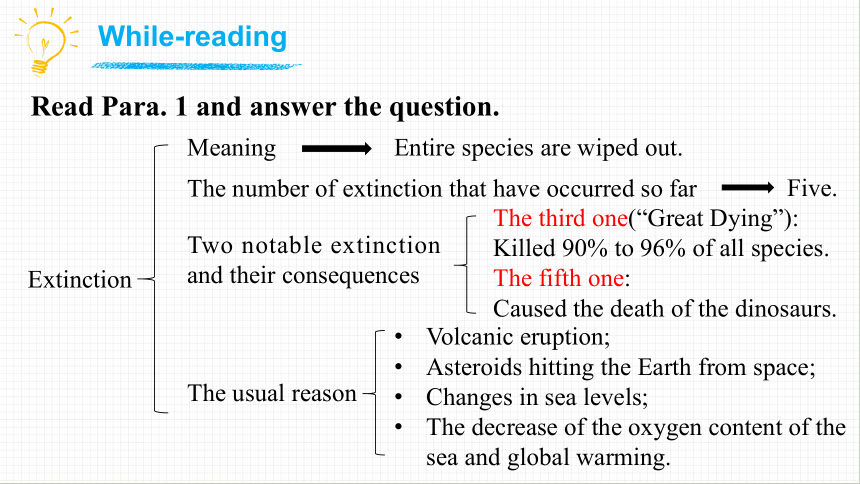

文档简介
(共15张PPT)
Lesson 1 The Sixth Extinction
Unit 3 Conservation
1.To read and talk about conservation;
2.To read for general understanding;
3.To read for specific information and understanding words in the context;
4.To express solutions to environmental problems.
Learning objectives
What can you see in the picture
1
What does extinction mean
2
Lead in
1. How many times up to today has life on Earth almost died out
a. Once b. Five times c. More than 10 times
2. About what percent of all species on Earth became extinct during the mass extinction known as the “Great Dying”
a. Less than 10% b. Nearly 50% c. More than 90%
3. What do scientists think will cause the next mass extinction
a. Human activity b. Natural causes c. Unknown reasons
How much do you know about them Choose the option based on your knowledge.
Pre-reading
Read the text about extinction and find the main idea for each paragraph.
Para.1
Para.2
Para.3
Para.4
a causes/reasons
b what might happen
c what we can do
d background history
While-reading
Read Para. 1 and answer the question.
Extinction
Meaning
The number of extinction that have occurred so far
Two notable extinction and their consequences
The usual reason
Entire species are wiped out.
Five.
The third one(“Great Dying”):
Killed 90% to 96% of all species.
The fifth one:
Caused the death of the dinosaurs.
Volcanic eruption;
Asteroids hitting the Earth from space;
Changes in sea levels;
The decrease of the oxygen content of the sea and global warming.
While-reading
Read Para. 2 and answer the question.
1. What did scientists find out in 2015
2. What are the main reasons that cause the sixth extinctions
Scientists found that human activity is causing species to die out 1,000 times faster than normal.
1) Air and water pollution; 2) Forests being destroyed;
3) Factory farming; 4) Overfishing.
Read Para. 3 and answer the question.
Why does the writer believe we’ll probably die out if 75% of the Earth’s species die out
Because our world and our lives depend on the balance in nature between animals and plants.
Read Para. 4 and answer the question.
What did people do in the case study to protect black robins Which claim(s) did the case study support in the text
Change the way we live;
Set up special areas for endangered species;
Change the way we work and travel;
Improve our farming methods to reduce water, air and land pollution.
Read The Black Robin and answer the question.
1. What did people do in the case study to protect black robins
2. Which claim(s) did the case study support in the text
The case study showed that even in desperate situations, we can do something to help. In short, it’s never too late.
Use different colored pens to highlight at least one example for each of the four elements listed below.
facts
opinions/predictions
reasons
solutions
Post-reading
· facts
· reasons
· opinions / predictions
· solutions
1
2
3
2
3
1
2
1
2
3
3
1
Think & answer
1. What text type is this piece of writing
2. What is its communicative purpose
3. What ways of argument does the writer use to convince readers Are you convinced Why or why not
2. What is its communicative purpose
Its purpose is to explain what the sixth extinction is and its effects and call on people to take action to prevent it from happening.
1. What text type is this piece of writing
This piece of writing is an exposition.
3. What ways of argument does the writer use to convince readers Are you convinced Why or why not
· The writer uses ways such as citing ideas from experts or authorities, giving examples and using data.
· I believe that if we take action now it is not too late to save other species from extinction. The black robin was saved from extinction when only five birds remained, so I think it is possible to save any species if we act right now.
Do you know any endangered species
What should we do to help them
South China Tiger
Yangtze River Dolphin
Tibetan Antelope
· Protect wildlife habitat.
· Recycle and buy sustainable products.
· Never purchase products made from threatened or
endangered species.
· …
Lesson 1 The Sixth Extinction
Unit 3 Conservation
1.To read and talk about conservation;
2.To read for general understanding;
3.To read for specific information and understanding words in the context;
4.To express solutions to environmental problems.
Learning objectives
What can you see in the picture
1
What does extinction mean
2
Lead in
1. How many times up to today has life on Earth almost died out
a. Once b. Five times c. More than 10 times
2. About what percent of all species on Earth became extinct during the mass extinction known as the “Great Dying”
a. Less than 10% b. Nearly 50% c. More than 90%
3. What do scientists think will cause the next mass extinction
a. Human activity b. Natural causes c. Unknown reasons
How much do you know about them Choose the option based on your knowledge.
Pre-reading
Read the text about extinction and find the main idea for each paragraph.
Para.1
Para.2
Para.3
Para.4
a causes/reasons
b what might happen
c what we can do
d background history
While-reading
Read Para. 1 and answer the question.
Extinction
Meaning
The number of extinction that have occurred so far
Two notable extinction and their consequences
The usual reason
Entire species are wiped out.
Five.
The third one(“Great Dying”):
Killed 90% to 96% of all species.
The fifth one:
Caused the death of the dinosaurs.
Volcanic eruption;
Asteroids hitting the Earth from space;
Changes in sea levels;
The decrease of the oxygen content of the sea and global warming.
While-reading
Read Para. 2 and answer the question.
1. What did scientists find out in 2015
2. What are the main reasons that cause the sixth extinctions
Scientists found that human activity is causing species to die out 1,000 times faster than normal.
1) Air and water pollution; 2) Forests being destroyed;
3) Factory farming; 4) Overfishing.
Read Para. 3 and answer the question.
Why does the writer believe we’ll probably die out if 75% of the Earth’s species die out
Because our world and our lives depend on the balance in nature between animals and plants.
Read Para. 4 and answer the question.
What did people do in the case study to protect black robins Which claim(s) did the case study support in the text
Change the way we live;
Set up special areas for endangered species;
Change the way we work and travel;
Improve our farming methods to reduce water, air and land pollution.
Read The Black Robin and answer the question.
1. What did people do in the case study to protect black robins
2. Which claim(s) did the case study support in the text
The case study showed that even in desperate situations, we can do something to help. In short, it’s never too late.
Use different colored pens to highlight at least one example for each of the four elements listed below.
facts
opinions/predictions
reasons
solutions
Post-reading
· facts
· reasons
· opinions / predictions
· solutions
1
2
3
2
3
1
2
1
2
3
3
1
Think & answer
1. What text type is this piece of writing
2. What is its communicative purpose
3. What ways of argument does the writer use to convince readers Are you convinced Why or why not
2. What is its communicative purpose
Its purpose is to explain what the sixth extinction is and its effects and call on people to take action to prevent it from happening.
1. What text type is this piece of writing
This piece of writing is an exposition.
3. What ways of argument does the writer use to convince readers Are you convinced Why or why not
· The writer uses ways such as citing ideas from experts or authorities, giving examples and using data.
· I believe that if we take action now it is not too late to save other species from extinction. The black robin was saved from extinction when only five birds remained, so I think it is possible to save any species if we act right now.
Do you know any endangered species
What should we do to help them
South China Tiger
Yangtze River Dolphin
Tibetan Antelope
· Protect wildlife habitat.
· Recycle and buy sustainable products.
· Never purchase products made from threatened or
endangered species.
· …
同课章节目录
- Unit 1 Relationshis
- Lesson 1 Teachers
- Lesson 2 How Do We Like Teachers’ Feedback?
- Lesson 3 So Close,Yet So Fa
- Unit 2 Success
- Lesson 1 Money vs Success
- Lesson 2 Top Five Secrets of Success
- Lesson 3 Getting to the Top
- Unit 3 Conservation
- Lesson 1 The Sixth Extinction
- Lesson 2 War on Plastic Packets
- Lesson 3 The Road to Destruction
